Answered step by step
Verified Expert Solution
Question
1 Approved Answer
TASK: Define the elements of the Distributive Justice theory of ethical action. In your definition, be sure to outline the steps required when attempting to
TASK: Define the elements of the Distributive Justice theory of ethical action. In your definition, be sure to outline the steps required when attempting to undertake an effective Distributive Justice analysis. Provide a Distributive Justice analysis of the Case of the Plant relocation. Detail and justify the decision you would recommend (as a Distributive Justice advocate) in this case.
Here are the case of the Plant Relocation
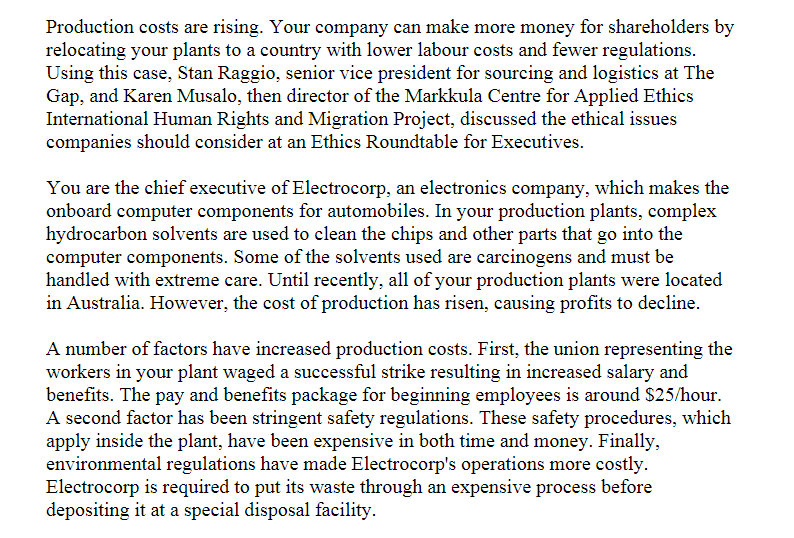
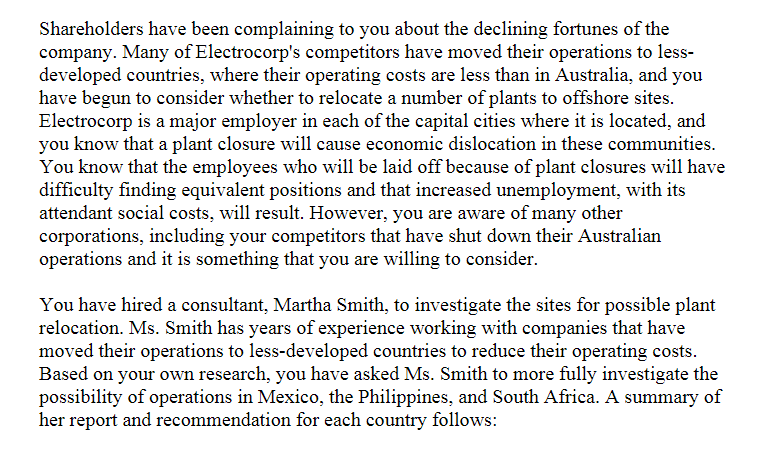
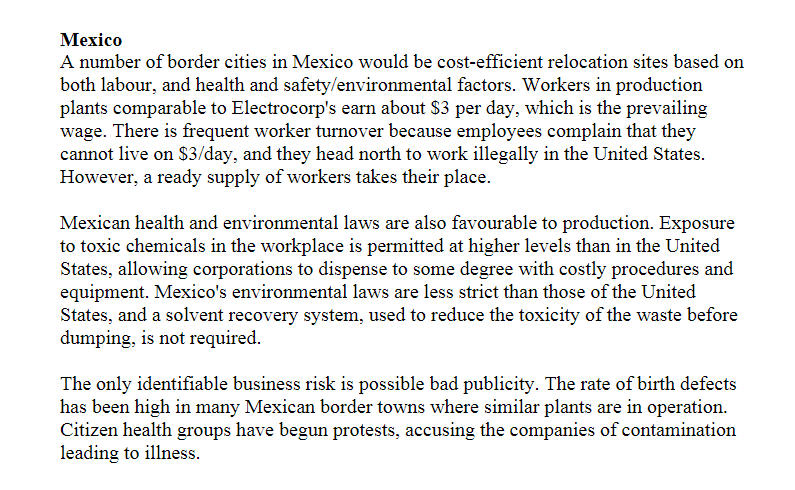
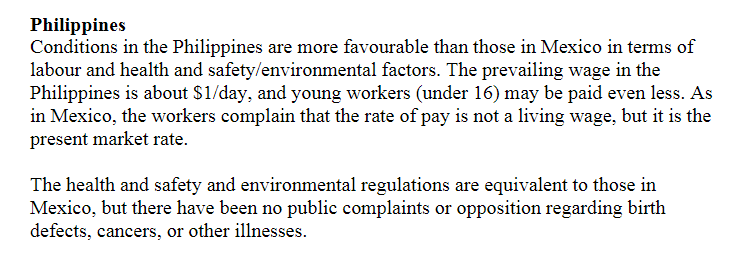
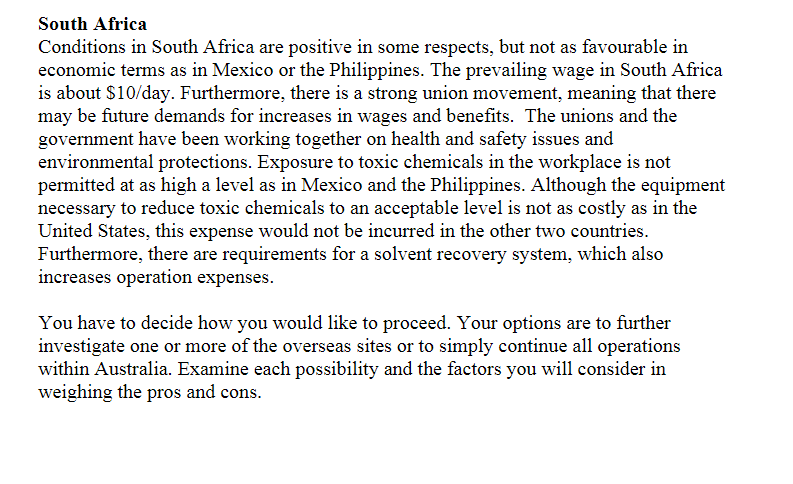
Show transcribed data
Production costs are rising. Your company can make more money for shareholders by relocating your plants to a country with lower labour costs and fewer regulations. Using this case, Stan Raggio, senior vice president for sourcing and logistics at The Gap, and Karen Musalo, then director of the Markkula Centre for Applied Ethics International Human Rights and Migration Project, discussed the ethical issues companies should consider at an Ethics Roundtable for Executives. You are the chief executive of Electrocorp, an electronics company, which makes the onboard computer components for automobiles. In your production plants, complex hydrocarbon solvents are used to clean the chips and other parts that go into the computer components. Some of the solvents used are carcinogens and must be handled with extreme care. Until recently, all of your production plants were located in Australia. However, the cost of production has risen, causing profits to decline. A number of factors have increased production costs. First, the union representing the workers in your plant waged a successful strike resulting in increased salary and benefits. The pay and benefits package for beginning employees is around $25/ hour. A second factor has been stringent safety regulations. These safety procedures, which apply inside the plant, have been expensive in both time and money. Finally, environmental regulations have made Electrocorp's operations more costly. Electrocorp is required to put its waste through an expensive process before depositing it at a special disposal facility. Shareholders have been complaining to you about the declining fortunes of the company. Many of Electrocorp's competitors have moved their operations to lessdeveloped countries, where their operating costs are less than in Australia, and you have begun to consider whether to relocate a number of plants to offshore sites. Electrocorp is a major employer in each of the capital cities where it is located, and you know that a plant closure will cause economic dislocation in these communities. You know that the employees who will be laid off because of plant closures will have difficulty finding equivalent positions and that increased unemployment, with its attendant social costs, will result. However, you are aware of many other corporations, including your competitors that have shut down their Australian operations and it is something that you are willing to consider. You have hired a consultant, Martha Smith, to investigate the sites for possible plant relocation. Ms. Smith has years of experience working with companies that have moved their operations to less-developed countries to reduce their operating costs. Based on your own research, you have asked Ms. Smith to more fully investigate the possibility of operations in Mexico, the Philippines, and South Africa. A summary of her report and recommendation for each country follows: Mexico A number of border cities in Mexico would be cost-efficient relocation sites based on both labour, and health and safety/environmental factors. Workers in production plants comparable to Electrocorp's earn about $3 per day, which is the prevailing wage. There is frequent worker turnover because employees complain that they cannot live on $3/ day, and they head north to work illegally in the United States. However, a ready supply of workers takes their place. Mexican health and environmental laws are also favourable to production. Exposure to toxic chemicals in the workplace is permitted at higher levels than in the United States, allowing corporations to dispense to some degree with costly procedures and equipment. Mexico's environmental laws are less strict than those of the United States, and a solvent recovery system, used to reduce the toxicity of the waste before dumping, is not required. The only identifiable business risk is possible bad publicity. The rate of birth defects has been high in many Mexican border towns where similar plants are in operation. Citizen health groups have begun protests, accusing the companies of contamination leading to illness. Philippines Conditions in the Philippines are more favourable than those in Mexico in terms of labour and health and safety/environmental factors. The prevailing wage in the Philippines is about $1/ day, and young workers (under 16) may be paid even less. As in Mexico, the workers complain that the rate of pay is not a living wage, but it is the present market rate. The health and safety and environmental regulations are equivalent to those in Mexico, but there have been no public complaints or opposition regarding birth defects, cancers, or other illnesses. South Africa Conditions in South Africa are positive in some respects, but not as favourable in economic terms as in Mexico or the Philippines. The prevailing wage in South Africa is about $10 /day. Furthermore, there is a strong union movement, meaning that there may be future demands for increases in wages and benefits. The unions and the government have been working together on health and safety issues and environmental protections. Exposure to toxic chemicals in the workplace is not permitted at as high a level as in Mexico and the Philippines. Although the equipment necessary to reduce toxic chemicals to an acceptable level is not as costly as in the United States, this expense would not be incurred in the other two countries. Furthermore, there are requirements for a solvent recovery system, which also increases operation expenses. You have to decide how you would like to proceed. Your options are to further investigate one or more of the overseas sites or to simply continue all operations within Australia. Examine each possibility and the factors you will consider in weighing the pros and consStep by Step Solution
There are 3 Steps involved in it
Step: 1

Get Instant Access to Expert-Tailored Solutions
See step-by-step solutions with expert insights and AI powered tools for academic success
Step: 2

Step: 3

Ace Your Homework with AI
Get the answers you need in no time with our AI-driven, step-by-step assistance
Get Started


